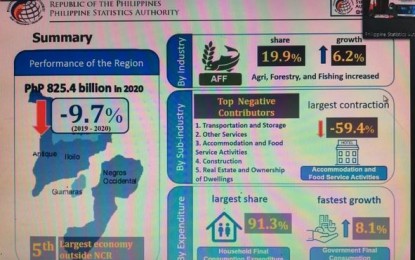
ECONOMIC PERFORMANCE. Western Visayas economy contracted by 9.7 percent in 2020 from its 6.3 percent growth in 2019. National Economic and Development Authority Western Visayas regional director Meylene C. Rosales, in her message during the presentation of the 2020 Report on the Economic Performance of Western Visayas on Thursday (April 29, 2021) said that Covid-19 has “disrupted the region’s growth trajectory.” (Photo from PSA virtual presentation)
ILOILO CITY – The agriculture, forestry, and fishing (AFF) sectors of Western Visayas (Region 6) posted a positive growth of 6.2 percent last year from its .5 percent performance in 2019, sharing 19.9 percent to the region’s economy.
“Region 6 has the fastest growth rate in AFF among the regions in the country,” said Philippine Statistics Authority (PSA) Western Visayas regional director Fred S. Sollesta in his presentation of the 2020 Report on the Economic Performance of Western Visayas on Thursday.
However, the region's economy in 2020 contracted by 9.7 percent from its 6.3 percent growth in the previous year.
The economic performance of the region is measured from the perspective of producers of goods and services through the gross regional domestic product (GRDP) and the expenditures of the residents of the region using the gross regional domestic expenditure (GRDE), he said.
Meylene C. Rosales, Western Visayas regional director of the National Economic and Development Authority (NEDA), said the coronavirus disease 2019 (Covid-19), as expected, resulted in “unprecedented health, economic and social repercussion”.
“What started as a health emergency has turned into a full-blown socio-economic crisis that unfortunately has disrupted the region’s growth trajectory,” she said.
The region’s economy slumped in 2020 after a consistent three-year positive growth rate, she added.
“Nonetheless, in terms of monetary value, Western Visayas still ranks as the fifth-largest economy among regions outside of NCR (National Capital Region). Based on the growth rate, the region ranked 11th among the regions in the country,” she said.
Rosales said the growth of the AFF could be a signal for the government to apportion more resources to the agriculture sector as it serves as the “saving grace” during this time of the pandemic.
“Agriculture stood out. So to me, it is just my opinion, it is now high time that we take a look at our agriculture sector. Although this is not to say that we have not been paying attention to the agri sector but what is needed is to add more,” she added.
Currently, Rosales said what is already in place is the Rice Tarrification Law, which is supposed to bring in more players in the rice industry that could help bring down the selling price making it more accessible to all.
“I think we need to ramp up our efforts on the Rice Tarrification Law,” she added.
If possible in 2022, the agriculture sector will be given a bigger budget to help farmers and fisherfolk, prop up their contribution and translate to higher production level, she said.
Meanwhile, Sollesta said the services sector, which accounted for 58.9 percent of the total economy, slowed down with its negative 14.3 percent performance from its eight percent growth rate in 2019.
Of its 11 sub-industries, the financial and insurance grew by 3.3 percent, public administration with its 3.9 percent, and information and communication with its 3.7 percent posted a positive growth performance last year.
The industry sector, with a 21.3 percent share in the economy, shrank to negative 8.9 percent from its 6.1 percent growth in 2019.
All its sub-industries namely manufacturing; construction; mining and quarrying; and electricity, steam, water, and waste management posted negative growth.
The total economic gross value added of the region, he said, was at PHP825.4 billion, a decrease of PHP 8.5 billion from the PHP913.9 billion in 2019. It was also the lowest since 2017.
In terms of GRDE, only the government final consumption expenditure grew faster by 8.1 percent from the 7.5 percent in 2019.
The contraction was recorded in household final consumption expenditure at negative 8.5; gross capital formation, negative 28 percent; exports of goods and services, negative 38.8 and import of goods and services, negative 17.5 percent.
“Of the 9.6 percent decline in the GDP (gross domestic product) of the country, Western Visayas was the fifth negative contributor with negative .5 percentage point and accounting for 4.7 percent share to the national GDP,” he added. (PNA)
